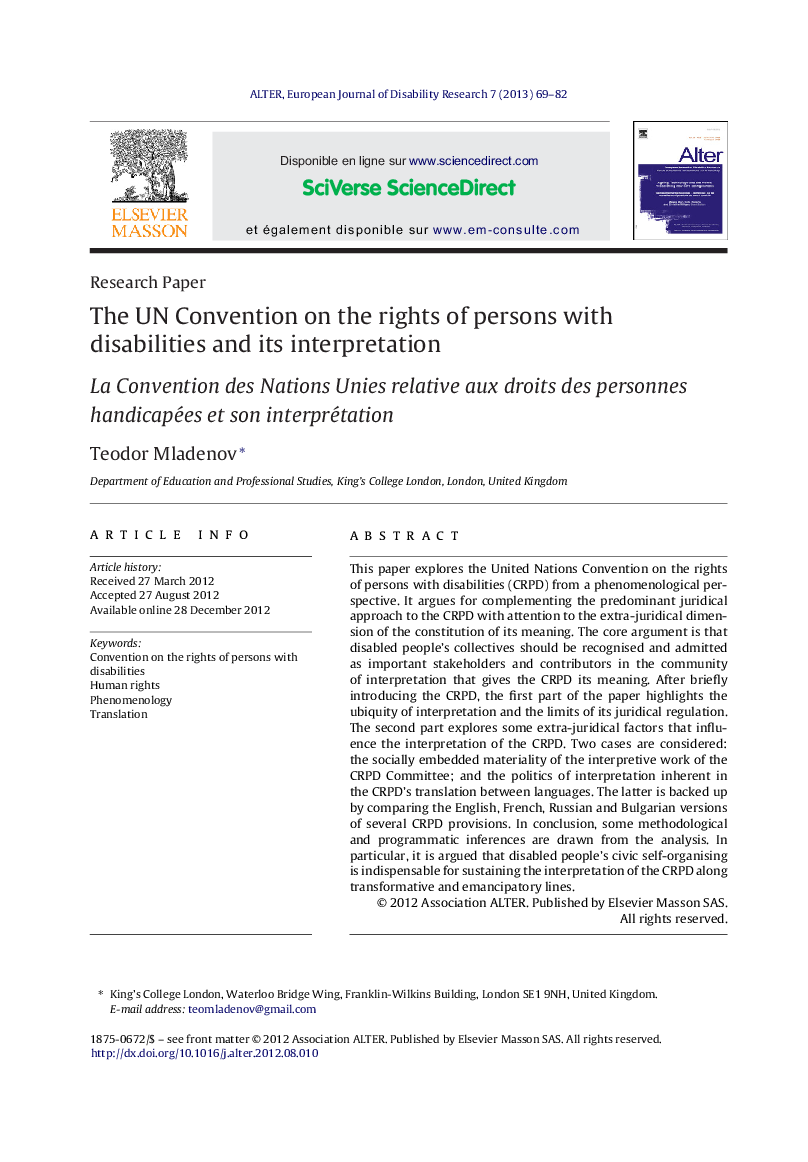| کد مقاله | کد نشریه | سال انتشار | مقاله انگلیسی | نسخه تمام متن |
|---|---|---|---|---|
| 1068089 | 949086 | 2013 | 14 صفحه PDF | دانلود رایگان |

This paper explores the United Nations Convention on the rights of persons with disabilities (CRPD) from a phenomenological perspective. It argues for complementing the predominant juridical approach to the CRPD with attention to the extra-juridical dimension of the constitution of its meaning. The core argument is that disabled people's collectives should be recognised and admitted as important stakeholders and contributors in the community of interpretation that gives the CRPD its meaning. After briefly introducing the CRPD, the first part of the paper highlights the ubiquity of interpretation and the limits of its juridical regulation. The second part explores some extra-juridical factors that influence the interpretation of the CRPD. Two cases are considered: the socially embedded materiality of the interpretive work of the CRPD Committee; and the politics of interpretation inherent in the CRPD's translation between languages. The latter is backed up by comparing the English, French, Russian and Bulgarian versions of several CRPD provisions. In conclusion, some methodological and programmatic inferences are drawn from the analysis. In particular, it is argued that disabled people's civic self-organising is indispensable for sustaining the interpretation of the CRPD along transformative and emancipatory lines.
RésuméCet article examine la Convention des Nations Unies relative aux droits des personnes handicapées (CDPH) d’un point de vue phénoménologique. Il propose de compléter l’approche juridique de la CDPH, approche dominante, en s’intéressant à la dimension extra-juridique de la construction du sens de la Convention. L’argument central est que les collectifs de personnes handicapées devraient être reconnus et admis comme parties prenantes et contributeurs importants de la communauté de ceux qui se prononcent sur l’interprétation de la CDPH et lui donnent son sens. Après une brève description de la CDPH, la première partie de l’article met en évidence l’omniprésence de l’interprétation et les limites de sa réglementation juridique. La deuxième partie explore certains facteurs extra-juridiques qui ont un impact sur l’interprétation de la CDPH. Deux cas sont considérés : l’enracinement social du travail d’interprétation du Comité de la CDPH et la politique de l’interprétation inhérente à la traduction de la CDPH dans les différentes langues. Cette dernière est étayée par la comparaison des versions anglaise, française, russe et bulgare de plusieurs clauses de la CDPH. En conclusion, quelques implications méthodologiques et programmatiques sont tirées de l’analyse. On soutient, en particulier, que l’auto-organisation civique des personnes handicapées est indispensable pour garantir l’interprétation de la CDPH dans un sens émancipatoire et de changement social.
Journal: ALTER - European Journal of Disability Research / Revue Européenne de Recherche sur le Handicap - Volume 7, Issue 1, January–March 2013, Pages 69–82